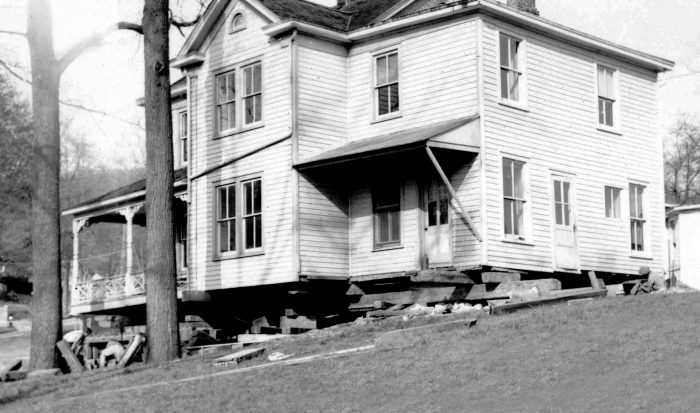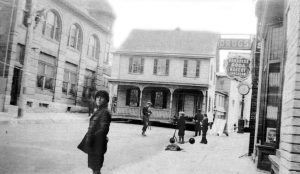Hometown History: Pulling up stakes — Moving buildings in early Port Jefferson

It was once common in Port Jefferson to see a house or other structure being moved from one location in the village to another.
Buildings were relocated to avoid flooding, preserve a historic property, clear the site for redevelopment, escape bad neighbors, profit from a land sale, improve the view and numerous other reasons.
The high costs of labor and materials generally made it less expensive to move a structure than to build anew. There was less concern with auto traffic, overhead utility lines, tree branches, and other obstacles that would impede a move in today’s Port Jefferson.
Using a wooden carriage system and the energy provided by a team of horses or oxen, early house movers — known as “machinists” — plied their trade. With the advent of modern technology, hydraulic jacking systems and dollies replaced the primitive equipment of yesteryear.

There are several references to the work of the village’s past house movers in the diary of Azariah H. Davis who chronicled life in nineteenth-century Port Jefferson. In May 1868, he recounted how the Townsend House on the southeast corner of the village’s Main and East Main streets was split in two halves and a new structure was erected in the center.
In a July 1868 entry, Davis noted that Port Jefferson tin merchant Tuthill Corwin had his “old shanty” moved from the village’s beach and in March 1870 that machinist John Marvin had moved “the old store which formerly belonged to James M. Bayles” of shipbuilding fame.
Francis A. Hawkins, a civil engineer and surveyor, was another of Port Jefferson’s original house movers. Among his many and varied contracts, he moved a boat shop from one side of Water Street (East Broadway) to the other and a shuttered jewelry store from East Main to West Broadway. Hawkins also turned around a house so that it would front on Myrtle Avenue.
Port Jefferson’s residents not only hired local house movers, but also their counterparts from outside of the village. In 1893, Napoleon Bonaparte Overton of Patchogue, who advertised himself as the “Great American House Mover,” was tasked with transporting a “wing” of the Townsend House to Echo (Port Jefferson Station).
Among other notable buildings that were relocated in Port Jefferson, in 1873 the Methodist Church was moved from Thompson to Spring Street. The chapel was sold at auction in 1893, moved to Main Street and remodeled as a storehouse, only to be destroyed in a 1904 fire.
The Custom House, which squatted in front of the Baptist Church at the intersection of East Main and Prospect streets, was moved in 1898 to 417 Myrtle Avenue and converted into a private residence.
The former home of Zachariah Hawkins, Port Jefferson’s first postmaster, stood near the southeast corner of Myrtle Avenue and Main Street. The house was moved to 204 Chestnut Street, allowing for the construction of Infant Jesus Roman Catholic Church, which opened in 1912.

The Point House, which once backed on the salt marsh in downtown Port Jefferson, was moved in 1922 from the west side of Main Street to its present location at 125 South Street.
In 1929, the home of village postmaster John M. Brown was moved to 105 Tuthill Street from its prior location on the northeast corner of Main and Tuthill streets where the New York Telephone Company subsequently built an office on the choice site.
Montfort, a Catholic home for handicapped children, was moved from the south side of Myrtle Avenue to make way for the building of Infant Jesus School, which was dedicated in 1938.
For the early residents of Port Jefferson, moving buildings was not only routine, but it also demonstrated their commitment to preservation, so often absent in the throwaway society of today.
Kenneth Brady has served as the Port Jefferson Village Historian and president of the Port Jefferson Conservancy, as well as on the boards of the Suffolk County Historical Society, Greater Port Jefferson Arts Council and Port Jefferson Historical Society. He is a longtime resident of Port Jefferson






